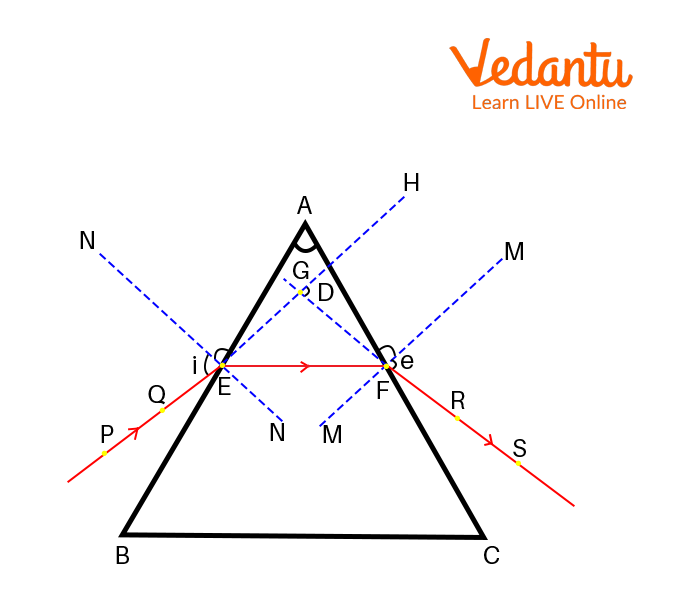




Step-by-Step Process of Light Refraction in a Glass Prism
Refraction of light through a prism is a fundamental topic in optics that demonstrates how light changes direction when passing through a transparent medium with non-parallel surfaces. Understanding this phenomenon is crucial for analyzing the behavior of light in various optical devices and for JEE Main preparation.
Structure and Properties of a Glass Prism
A typical glass prism is a transparent optical element with two triangular bases and three rectangular lateral surfaces. These surfaces are inclined to each other and are not parallel, resulting in unique optical effects when light passes through the prism.

Prisms are commonly made from materials such as crown glass or flint glass. The choice of material depends on the required refractive index and the intended optical application. Basic understanding of prism structure assists in grasping the subsequent refraction behavior.
A comparison between glass prisms and parallel-sided optical elements such as slabs is useful for understanding the difference in light path deviation. For details on refraction through slabs, refer to Refraction Of Light Through Glass Slab.
Basic Principles of Refraction Through a Prism
Refraction of light occurs when a light ray travels obliquely from one transparent medium to another with different optical densities. In a prism, this leads to changes in the direction of the incident ray at both entry and exit surfaces.

When a light ray enters the first face of a glass prism from air, it passes from a rarer to a denser medium and bends toward the normal. Upon exiting the second face into air, now from a denser to a rarer medium, the ray bends away from the normal.
This two-stage refraction causes the emergent ray to deviate from its original path. The extent of deviation depends on the prism’s geometry and the refractive indices involved. Related information about sign conventions in optical refraction can be found at Sign Convention In Lenses.
Key Angles and Ray Diagram in Prism Refraction
The path of a light ray through a prism is characterized by specific angles. The incident, refracted, and emergent rays make defined angles with the normals at their respective surfaces. The internal refracted ray connects the entry and exit points within the prism.
The following notations are standard for prism ray diagrams:
- Angle of Prism ($A$): Angle between two refracting faces
- Angle of Incidence ($i$): Incoming ray’s angle with the normal at entry
- Angle of Refraction ($r_1$, $r_2$): Angles inside the prism at entry and exit
- Angle of Emergence ($e$): Angle with normal at the exit face
- Angle of Deviation ($D$): Total shift of the emergent ray from the incident direction
The angle of deviation quantifies how much the emergent ray has turned compared to the incident ray. For in-depth coverage, see Angle Of Deviation In Prism.
Analytical Expression for Deviation in a Prism
The deviation angle ($D$) for a prism with small angle $A$ and refractive index $n$ is given by:
$D = (n - 1)A$
This expression applies under the condition of minimum deviation when the path of light inside the prism is symmetrical. A more general relationship involves the angle of incidence $i$, the angle of emergence $e$, angle of prism $A$, and the refractive index $n$:
$n = \dfrac{\sin\dfrac{A + D}{2}}{\sin\dfrac{A}{2}}$
Experiment: Refraction of Light Through a Prism
In the laboratory, the experiment involves directing a narrow ray of light at one face of a triangular prism and tracing its path as it emerges. Typical observation tables record angles of incidence, emergence, and deviation, confirming theoretical predictions.
| Angle Observed | Measured Value |
|---|---|
| Angle of Incidence ($i$) | Varies (e.g. $30^\circ$–$60^\circ$) |
| Angle of Emergence ($e$) | Measured for each $i$ |
| Angle of Deviation ($D$) | Recorded for each $i$ |
Understanding the observation table is important for analyzing the systematic behavior of light in a prism and recognizing the condition for minimum deviation. For graphical and simulation-based understanding of the experiment, refer to resources on Understanding Prisms.
Dispersion of Light by a Prism
When white light passes through a prism, it splits into its component colors due to different wavelengths experiencing different refractive indices. This process is called dispersion, resulting in the visible spectrum.

The refractive index for violet light is greater than that for red light, so violet bends more, forming the lower end of the spectrum, while red bends least and forms the upper end. This is due to the inverse relationship between wavelength and deviation inside the prism material.
Difference Between Refraction and Dispersion in a Prism
Refraction in a prism refers to the change in direction of any single light ray due to differences in optical density, while dispersion involves the separation of white light into its constituent colors by differential refraction of each wavelength.
- Refraction changes direction of incident light ray
- Dispersion splits white light into a color spectrum
- Red light deviates least; violet light deviates most
Applications of dispersion include spectroscopes and rainbow formation. These principles have significant roles in optical technology and in natural optical phenomena. For related concepts involving real and virtual images, refer to Virtual Image And Real Image.
Solved Example: Calculating Speed of Light in a Medium
Given: Refractive index of water $n = 1.33$, speed of light in air $c = 3 \times 10^8$ m s$^{-1}$. To find speed of light in water ($v$):
$n = \dfrac{c}{v}$
Hence, $v = \dfrac{c}{n} = \dfrac{3 \times 10^8}{1.33} = 2.25 \times 10^8$ m s$^{-1}$.
Practical Applications and Observations
Glass prisms find use in spectrometers, microscopes, telescopes, binoculars, and periscopes. They are essential for achieving precise optical deviation and for analyzing spectral composition of light sources.
Atmospheric refraction, dispersion in rain droplets, and optical instrument design all rely on these principles. Prism applications extend to fields such as astronomy, vision testing, and laser technology. For wave-related reflection and transmission, visit Reflection And Transmission Of Waves.
FAQs on Understanding How Light Refracts Through a Prism
1. What is refraction of light through a prism?
Refraction of light through a prism is the bending of light as it passes obliquely from one medium to another inside a prism, causing the light to change direction and often split into its constituent colours.
- The incident light enters the prism at one face, bends towards the base due to refraction, and emerges from the other face with a different direction.
- This phenomenon is governed by the change in speed of light as it enters a denser or rarer medium inside the prism.
- Prisms are commonly used in scientific experiments to study dispersion and the visible spectrum.
2. What causes the dispersion of white light by a prism?
Dispersion of white light by a prism is caused by the different degrees of bending (refraction) each colour experiences due to varying wavelengths.
- White light is a mixture of different colours.
- Each colour bends by a different amount when passing through a prism (violet bends the most, red bends the least).
- This separation forms a spectrum of colours, often observed as a rainbow-like pattern.
3. How does the angle of deviation in a prism depend on the angle of incidence?
The angle of deviation is the angle between the direction of incident light and the emergent light as it passes through a prism.
- As the angle of incidence increases, the angle of deviation first decreases and then increases, reaching a minimum value at a specific incidence called the angle of minimum deviation.
- The phenomenon helps determine the refractive index of the prism material.
4. What is the angle of minimum deviation in a prism?
Angle of minimum deviation is the smallest possible value of deviation experienced by a ray passing through a prism when the light ray passes symmetrically.
- This is achieved when the angle of incidence and the angle of emergence are equal.
- It is a key point used in calculating the refractive index of the prism.
5. Why does a prism split white light into its constituent colours but a glass slab does not?
A prism splits white light because of its non-parallel boundary surfaces, causing different colours to refract at different angles due to their different speeds in glass.
- A glass slab has parallel faces, so after refraction the colours emerge parallel without splitting.
- This unique property of prisms is called dispersion.
6. Which colour of visible light bends the most in a prism and why?
Violet light bends the most in a prism because it has the shortest wavelength among visible colours, causing it to refract more than others.
- The shorter the wavelength, the greater the bending.
- Red light bends the least due to its longer wavelength.
7. Explain the path of a light ray passing through a glass prism using a labelled diagram.
A ray of light entering a prism gets refracted twice, changing direction and deviating towards the base.
- At the first face (AB), the incident ray bends towards the normal inside the prism.
- At the second face (AC), the ray bends away from the normal as it exits the prism.
- The total angle between the original and final paths is the angle of deviation.
8. What is meant by the refractive index of a prism and how is it calculated?
Refractive index of a prism measures how much light bends when entering the prism material.
- It is calculated using the formula: n = sin((A + Dmin)/2) / sin(A/2)
- Here, A is the angle of the prism and Dmin is the angle of minimum deviation.
9. What are the applications of refraction through a prism?
Refraction through a prism is used in various scientific and real-life applications.
- To study spectra and the components of light.
- In spectrometers for chemical analysis.
- In optical instruments like binoculars and periscopes.
- For creating rainbow effects in decorative items.
10. State the laws of refraction as applied to a glass prism.
Laws of refraction (Snell's Law) govern how light changes direction at the boundaries of a prism.
- The incident ray, refracted ray, and normal all lie in the same plane.
- The ratio of sine of angle of incidence to sine of angle of refraction is constant for a given wavelength and material (n = sin i / sin r).
- These laws explain light's behaviour during entry and exit in the prism.




























